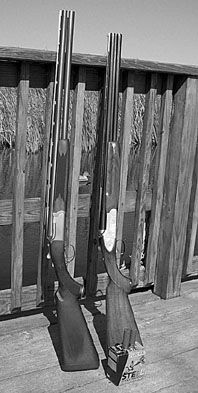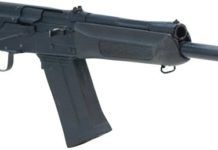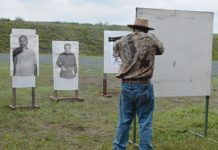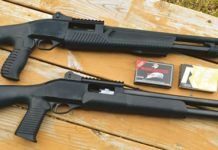
The big boys in most duck and goose blinds have historically been the semi-automatics or pumps that can sling shells all over creation as hunters hammer incoming waterfowl.
Some hunters who have grown tired of plucking empty hulls out of their ears or watching shells fly across their field of view as they stand beside their shooting buddies are checking out over-and-under shotguns for their waterfowl scatterguns. Many have come to accept the fact that two quality shots are just as effective as three sky-busting blasts from a semi-auto or pump. More control of the ejected shells (over and unders kick hulls out over the shooter’s shoulder, rather than to the side) is another bonus.
These waterfowl over-and-unders may not be the high-dollar, finely engraved firearms that can be found lovingly nestled in the arms of shooters on quail or clay target fields, but they are hard-working tools that get the job done. Two shotguns that have been recently introduced as potential waterfowl busters are the Ruger All-Weather Red Label Target Grey Model and the Charles Daly Empire II EDL Hunter AE-MC Model. Both of the over-and-under shotguns have 3-inch chambers and carry a price tag of under $1,650.
Because of their design, most stack-barrel firearms will have greater recoil than gas-operated semi-autos if the shooter fires the heavy 3-inch loads. Our two test shotguns were no exception to this rule, causing our test crew to limit the number of big shells they fired as part of the testing.
Recoil was particularly powerful with the Ruger 12 Gauge No. 411-62071, $1,545, manufactured by Sturm, Ruger & Co., Inc. of Southport, Connecticut. With its hollow, lightweight synthetic stock, the Ruger was less than a joy to shoot when 3-inchers came into play. In several instances, the Ruger’s safety was clicked on by the recoil of 3-inch shells and had to be pushed forward to allow for a second shot. More weight in the back end of the shotgun, either added inside the hollow stock or with an after-market recoil reducer, would help alleviate that shoulder punch.
While the recoil problem with heavy loads was not as great in the Empire II EDL Hunter, manufactured by Charles Daly Inc. of Harrisburg, Pennsylanvia, there were several times when the top lever slipped into the closed position before the action was closed. This complicated the loading process that is normally a simple procedure with an over and under.
None of the recoil problems were encountered when the 2.75-inch ammunition was loaded and fired, even with the short magnum loads. The consensus of the testers was that, at least with these two over and unders, shooters might be advised to save the 3-inch sky blasting for semi-autos or pumps.
Our setting for putting the two shotguns through their paces in both waterfowl and clay target situations was the 28,000-acre, 74 Ranch Resort, (phone [830] 579-7474, Box 38, Campbellton, Texas 78008). The hunting resort is dotted with duck blinds on tanks and ponds scattered about the property, with several hunting locations just a short jog from a 16-station sporting clays course that offers a multitude of testy targets.
For our test ammunition, our group was equipped with Federal 3-inch, 1.25-ounce loads of steel BB shot that have a muzzle velocity of 1,300 fps; Federal 2.75-inch, 1 1/8-ounce loads of steel No. 2 shot, also with a muzzle velocity of 1,300 fps; and Federal Top Gun 2.75-inch, 1 1/8-ounce loads of No. 8 shot with a muzzle velocity of 1,200 fps.
Here’s our report:
[PDFCAP(1)]
With its target-grey metal parts and black synthetic stock and forearm, this shotgun looks like it belongs in a duck blind. No shiny parts to reflect sunlight, yet the Ruger exhibits a classy profile and fine lines of a quality hunting tool.
Our test gun measured 47 inches in overall length with a barrel 30 inches long and a slight feel of heaviness toward the muzzle. This weight differential in the 7.75-pound firearm could be attributed to the hollow synthetic stock noted earlier.
Balance and maneuverability did not seem to be affected, with the shotgun easily gliding through targets. The length of pull on the test gun was 14.4 inches, fitting all of the test shooters. Drop at the comb was 1.6 inches, and drop at the heel was 3 inches.
This stock profile, combined with a pitch of 4 inches, could be one of the reasons that the shotgun’s recoil was a little sharper than anticipated. A greater pitch can result in more impact into a shooter’s shoulder because it increases the angle of the recoil.
One of the big pluses with the Ruger came when the shooters needed to switch from open chokes used for the steel shot to the tighter chokes for the sporting clays field. The choke-tube wrench that is a standard item with each Ruger over and under is simple to use. In addition, each choke is clearly marked on the side to leave no doubt about what constriction is being put into the barrel. A good choke wrench and clear choke designations are a big benefit when a shooter has to change chokes with any regularity.
Other than the recoil situation with 3-inch shells, the Ruger functioned as it should. The automatic safety (which engages whenever the action is opened) also serves as the barrel selector. Whatever letter is exposed (B for bottom and T for top) is the barrel that fires first.
A non-automatic safety, preferred by many clay target shooters, is available if the shotgun is returned to the Ruger factory for customizing.
[PDFCAP(2)]
Although listed as a “Hunter” model, this shotgun features gold inlay in a silver-engraved receiver and a high-gloss finish on the European walnut stock and forearm. The nine gold inlays of a dog and seven ducks stretches across the sidelock plates and under the receiver, and the shotgun’s trigger is gold plated.
Looking at the fine display brings to mind the scene in the movie The Dirty Dozen where a soldier posing as a general is reviewing a commander’s honor guard and says: “Very pretty Colonel, but can they fight?”
After putting the Charles Daly through its review, the answer to that question is, “Yes. It’s both pretty and can do its job.”
Our test gun had an overall length of 45 inches, with 28-inch, polished blue barrels. The length of pull was 14.2 inches, with a drop at the comb of 1.5 inches and drop at the heel of 2 inches. The trigger pull was 5 pounds, with creep in both triggers, and the weight of the 28-inch barreled shotgun was an even 7 pounds. Pitch was just 1 inch, which could be the reason recoil was less of a factor, even with the lighter, shorter-barreled shotgun.
Unlike the Ruger, the chokes for the Charles Daly were hard to identify, as only the number of notches in the end of the chokes could be used to determine their constriction. The choke tube wrench was a circular piece of metal with a round bar through the top. An aftermarket wrench, similar to the Ruger wrench, would be a good addition for anyone wanting to change chokes very often.
Another concern with the Charles Daly, which also featured an automatic safety that serves as a barrel selector, is that there are no markings beside the safety to designate which barrel will fire. Through trial and error, we discovered that the shotgun fires the bottom barrel first when the lever is to the right, and the top barrel first when the lever is to the left.
Shooting the Charles Daly was a pleasurable experience, except with the 3-inch shells because of the recoil. Testers were satisfied with the shotgun’s target-breaking abilities. The shotgun’s rib is 10 mm wide, which provides a good sighting ramp, and the red bead front sight easily catches the shooter’s eye. As with the Ruger, we had no complaints about the handling qualities of the over and under in the duck blind or on the clays course.
Gun Tests Recommends
Ruger All-Weather Red Label Target Grey Model 12 Gauge, $1,545. Our Pick. Quick handling even with its 30-inch barrels and its rugged finish put this shotgun on top of the testers’ list. The choke wrench and choke labeling system were outstanding for a field shotgun. Adding more weight to the stock would be recommended to reduce the recoil.
Charles Daly Empire II EDL Hunter AE-MC 12 Gauge, $1,639. Buy It. Maybe a little pretty for rugged use in a duck blind, this is still a quality shotgun that performed well in various shooting situations. The light weight of the 28-inch barrels caused the shotgun to be a little whippy on long-distance targets. Upgrading the barrel selector and the choke identification systems would be a big plus for this fine shotgun.
Also With This Article
[PDFCAP(3)]






























